
by DGR News Service | Mar 8, 2021 | Education, Movement Building & Support, Repression at Home, Strategy & Analysis
In this article Max Wilbert outlines the political and environmental need for security culture. He offers recommendations to secure communications.
By Max Wilbert
For 50 days, the Protect Thacker Pass camp has stood here in the mountains of northern Nevada, on Northern Paiute territory, to defend the land against a strip mine.
Lithium Americas, a Canadian corporation, means to blow up, bulldoze, or pave 5,700 acres of this wild, biodiverse land to extract lithium for “green” electric cars. In the process, they will suck up billions of gallons of water, import tons and tons of waste from oil refineries to be turned into sulfuric acid, burn 11,000 gallons of diesel fuel per day, toxify groundwater with arsenic, antimony, and uranium, harm wildlife from Golden eagles and Pronghorn antelope to Greater sage-grouse and the endemic King’s River pyrg, and lay waste to traditional territories still used by people from the Fort McDermitt reservation and the local ranching and farming communities.
The Campaign to Protect Thacker Pass
They claim this is an “environmentally sustainable” project. We disagree, and we mean to stop them from destroying this place.
Thus far, our work has been focused on outreach and spreading the word. For the first two weeks, there were only two of us here. Now word has begun to spread. The campaign is entering a new stage. There are new opportunities opening, but we must be cautious.
How Corporations Disrupt Grassroots Resistance Movements
Corporations, faced with grassroots resistance, follow a certain playbook. We can look at the history of how these companies respond to determine their strategies and the best ways to counteract them.
Corporations like Lithium Americas Corporation generally do not have in-house security teams, beyond basic security for facilities and IT/digital security. Therefore, when faced with growing grassroots resistance, their first move will be to hire an outside corporation to conduct surveillance, intelligence gathering, and offensive operations.
Private Military Corporations (PMCs) are essentially mercenaries acting largely outside of government regulation or democratic control. They are hired by private corporations to assist in their interests and act as for-hire businesses with few or no ethical considerations. Some examples of these corporations are TigerSwan, Triple Canopy, and STRATFOR.
PMCs are often staffed with U.S. military veterans, and employ counterinsurgency techniques and skills honed during the invasions of Iraq and Afghanistan, or other military operations. And in many cases, these PMCs collaborate with public law enforcement agencies to share information, such that law enforcement is essentially acting as a private contractor for a corporation.
Disruption Tactics Used by Corporate Goon Squads
PMCs can be expected to deploy four basic tactics.
- Intelligence Gathering
First, they will attempt to gather as much information on protesters as possible. This begins with what is called OSINT — Open Source Intelligence. This simply means combing through open records on the internet: Googling names, scrolling through social media profiles and groups, and compiling information that is publicly available for anyone who cares to look.
Other methods of information gathering are more active, and include physical surveillance (such as flying a helicopter overhead, as occurred today), signals intelligence (attempting to capture cell phone calls, emails, texts, and website traffic using a device like a Stingray also known as an IMSI catcher), and infiltration or human intelligence (HUMINT). This last is perhaps the most important, the most dangerous, and the most difficult to combat.
- Disruption
Second, they will attempt to disrupt the protest. This is often done by using the classic tactics of COINTELPRO to plant rumors, false information, and foment infighting to weaken opposition.
During the protests against the Dakota Access Pipeline, one TigerSwan infiltrator working inside the protest camps wrote to his team that
“I need you guys to start looking at the activists in your area and see if there are individuals who are vulnerable. They’re broke, always talking about needing gas money or whatever. Maybe they’re disillusioned, depressed a little. Life is fucking them over. We can buy them a bus ticket to any camp they want if they’re willing to provide intel. We win no matter what. If they agree to inform for pay, we get intel. If they tell our pitchman to go f*** himself/herself, the activist will start wondering who did take the money and it’ll cause conflict within the activist groups and it won’t cost us anything.”
In 2013, there was a leak of documents from the private intelligence company STRATFOR, which has worked for the American Petroleum Institute, Dow Chemical, Northrup Grumman, Coca Cola, and so on. The leaked documents revealed one part of STRATFOR’s strategy for fighting social movements. The document proposes dividing activists into four groups, then exploiting their differences to fracture movements.
“Radicals, idealists, realists and opportunists [are the four categories],” the leaked documents state. “The Opportunists are in it for themselves and can be pulled away for their own self-interest. The Realists can be convinced that transformative change is not possible and we must settle for what is possible. Idealists can be convinced they have the facts wrong and pulled to the Realist camp. Radicals, who see the system as corrupt and needing transformation, need to be isolated and discredited, using false charges to assassinate their character is a common tactic.”
As I will discuss later on, solidarity and movement culture is the best way to push back against these methods.
Other examples of infiltration and disruption have often focused on:
- Increasing tensions around racist or sexist behavior
- Targeting individuals with drug or alcohol addictions to become informants
- Using sex appeal and relationship building to get information
- Acting as an “agent provocateur” to encourage protesters to become violent, even to the point of supplying them with bombs, in order to secure arrests
- Spreading rumors about inappropriate behavior to sew discord and mistrust
- Intimidation
The third tactic used by these companies is intimidation. They will use fear and paranoia as a deliberate form of psychological warfare. This can include anonymous threats, shows of force, visible surveillance, and so on.
- Violence
When other methods fail, PMCs and public law enforcement will ultimately resort to direct violence, as we have seen with Standing Rock and many other protest movements.
As I have written before, colonial states enforce their resource extraction regimes with force, and we should disabuse ourselves of notions to the contrary. Vigilante violence is also always a concern. When people seek to defend land from destruction, men with guns are usually dispatched to arrest them, remove them from the site, and lock them in cages.
How to Resist Against Surveillance and Repression
There are specific techniques we can deploy to protect ourselves, and by extension, protect the land at Thacker Pass. These techniques are called “security culture.”
Security culture is a set of practices and attitudes designed to increase the safety of political communities. These guidelines are created based on recent and historic state repression, and help to reduce paranoia and increase effectiveness.
Security culture cannot keep us 100% safe, all the time. There is risk in political action. But it helps us manage risks that do exist, and take calculated risks when necessary to achieve our goals.
The first rule of security culture is this: be cautious, but do not live in fear. We cannot let their intimidation be effective. Creating paranoia is a key goal for PMCs and other repressive organizations. When they make us so paranoid we no longer take action, reach out to potential allies, or plan and carry out our campaigns, they win using only the techniques of psychological warfare. When we are fighting to protect the land and water, we are doing something righteous, and we should be proud and stand tall while we do this work.
The second rule of security culture is that solidarity is how we overcome paranoia, snitchjacketing, and rumor-spreading. We must act with principles and in a deeply ethical and honorable way. Work to build alliances, friendships, and trust—while maintaining good boundaries and holding people accountable. This is the foundation of a good culture.
In regards to infiltration, security culture recommends the following:
- It’s not safe nor a good idea to generally speculate or accuse people of being infiltrators. This is a typical tactic that infiltrators use to shut movements down.
- Paranoia can cause destructive behavior.
- Making false/uncertain accusations is dangerous: this is called “bad-jacketing” or “snitch-jacketing.”
- Build relationships deliberately, and build trust slowly. Do not share sensitive information with people who don’t need to know it. There is a fine line between promoting a campaign and sharing information that could put someone at risk.
- Good security culture focuses on identifying and stopping bad behavior.
- Do not talk to police or law enforcement unless you are a designated liaison.
Secure communications are an important part of security culture.
Here are some basic recommendations to secure your communications.
- Email, phone calls, social media, and text messages are inherently insecure. Nothing sensitive should be discussed using these platforms.
- Preferably, use modern secure messaging apps such as Signal, Wire, or Session. These apps are free and easy to use.
- We recommend setting up and using a VPN for all your internet access needs at camp. ProtonVPN and Firefox VPN are two reputable providers. These tools are easy to use after a brief initial setup, and only cost a small amount. Invest in security.
We must also remember that secure communications aren’t a magic bullet. If you’re communicating with someone who decides to share your private message, it’s no longer private. Use common sense and consider trust when using secure communications tools.
Security culture also warns us not talk about some sensitive issues, including:
- Your or someone else’s participation in illegal action.
- Someone else’s advocacy for such actions.
- Your or someone else’s plans for a future illegal action.
- Don’t talk about illegal actions in terms of specific times, people, places, etc.
Note: Nonviolent civil disobedience is illegal, but can sometimes be discussed openly. In general, the specifics of nonviolent civil disobedience should be discussed only with people who will be involved in the action or those doing support work for them. It’s still acceptable (even encouraged) to speak out generally in support of monkeywrenching and all forms of resistance as long as you don’t mention specific places, people, times, etc.
Conclusion
Security is a very important topic, but is challenging. There are so many potential threats, and we are not used to acting in a secure way. That’s why we are working to create a “security culture”—so that our communities of resistance are always considering security, assessing threats, studying our opposition, and creating countermeasures to their methods.
This article is only a brief introduction to the topic of security culture. Moving forward, we will be providing regular trainings in security culture to Protect Thacker Pass participants.
Most importantly, do not let this scare you, and do not be overwhelmed. Simply take one security measure at a time, begin to study it, and then implement better protocols one by one. We use the term “security culture” because security is a mindset that should be developed and shared.
Resources:
Recommended topics of study:
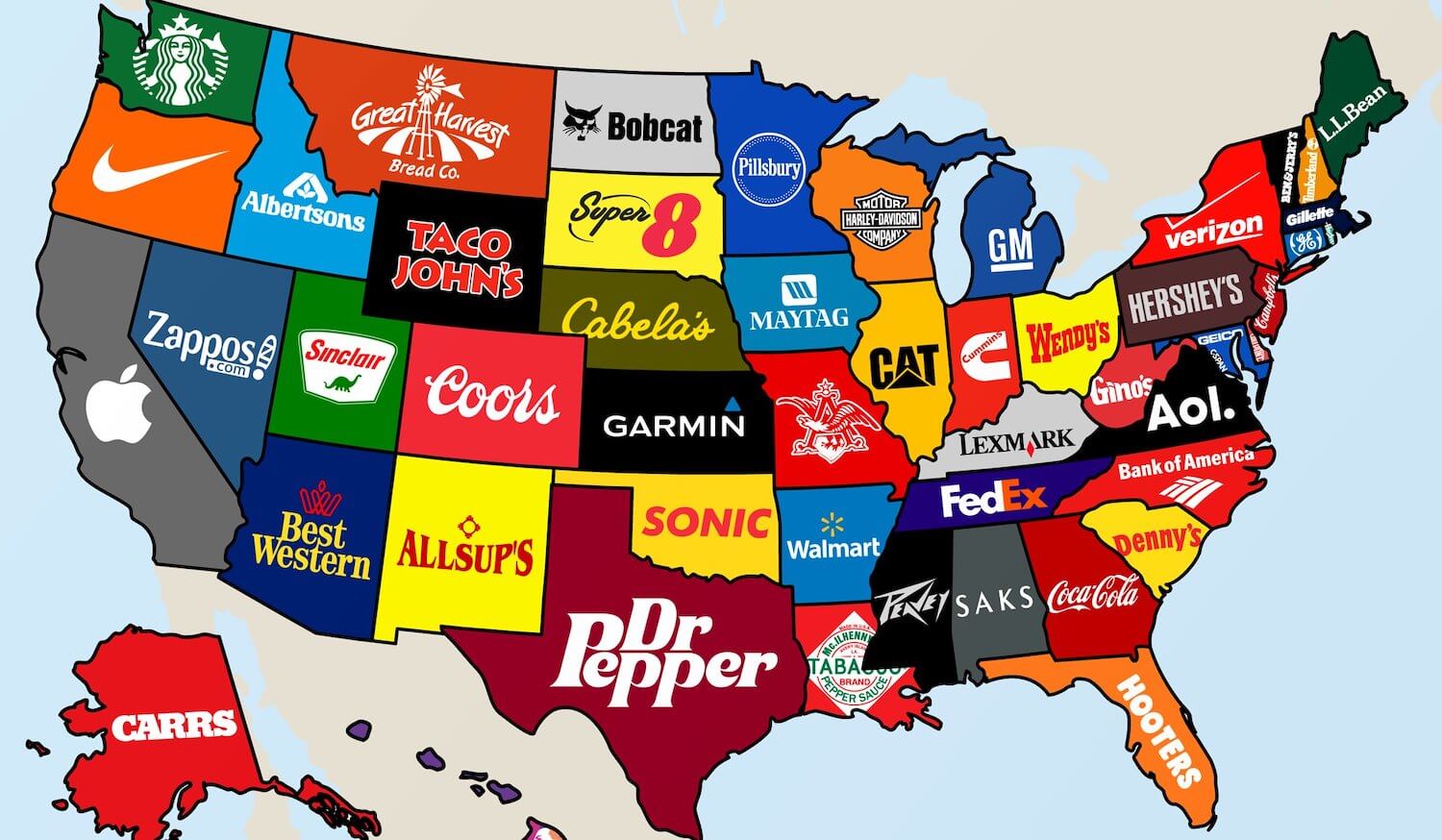
by DGR News Service | Apr 24, 2020 | The Problem: Civilization
Corporations are driven by a necessity to privatize profits and externalize costs. In this article, Suresh Balraj highlights how the concept of limited liability further reduces the accountability of corporations to the consequences of their actions, and asks “how can we hold corporations accountable?”
The Myth of Limited Liability
By Suresh Balraj
Prof. Nicholas Murray, former president of Columbia University, might have been wrong when he said : “The limited-liability corporation is the greatest invention of modern times”; simply because, there is nothing original about limited liability at all. In fact, it wraps new language around a concept that is as old as ‘civilisation’ itself – that of enriching rulers at the expense of the majority of humans and their non-human communities.
The American anthropologist Stanley Diamond noted : “Civilisation originates in conquest abroad and repression at home”; certainly, he is not the only one to remark that the central goal and function of the State has been, from the very beginning, that of robbing the poor in order to feed the rich.
One of the founding fathers of the American constitution, James Madison, also insisted – in the 18th century – that the main goal of the political system should be to protect the minority (elites) against the majority.
Besides, the Godfather of economics, Adam Smith, wrote : “Civil government … is instituted for the defence of the rich against the poor or of those who have some property against those who have none at all”. But, including John Locke, who stated that the State has no other end other than the preservation of property, were all being rather modest. The reason being, the main function of the State actually goes even further; not only to just protect, but more importantly, to acquire more and more property for the opulent.
In other words, from the very beginning, the one and the only goal/objective has been the privatisation of profits and the externalisation of costs; and, the only question : how best to do this ?
Force is, of course, one way. For which, we need to probably ask the Africans, for example – more than 100 million dead during the slave trade alone; or, for that matter, the ‘American Indians’, who were decimated a dozen times over in the conquest of their homeland. Another very striking example of the times would be the scores of indigenous communities, across the globe, who continue to be both dispossessed and exterminated (as rapidly as those who came before them).
Or even better, would be to ask a present, modern day slave; for example, the e-coolies in ‘bondage’ in sweatshops and bodyshops – couched in technical jargons, such as, silicon valley, technopark, infopark, infocity, blue-chip, six-sigma and fortune 500/1000.
However, at the end of the day, force is expensive or economically unviable, at least in the long run. Therefore, it would be simply great, if you could convince the very victims to participate or co-operate in the process of their victimisation. Thus, in ancient times, those in power invoked the divine right of the feudal lords (kings) – trying to convince not only themselves, but particularly, those from whom they usurped both life and property; as a result, anyone who dares to oppose this divine intervention or Godly incarnation shall be subject to eternal condemnation.
Obviously, this was possible during the pseudo-religious era – the ‘dark’ ages. But, in today’s so called civilised world, this might seem to be pretty extreme. For example, if those in power said that Warren Anderson, the mass murderer of the victims of Union Carbide in Bhopal, India, in 1984 – the worst air pollution disaster in the history of humankind – should not be executed due to a divine mandate, it would then make a mockery of the rule of law.
So the powerful had come up with a different way to keep the victims of their misdemeanours from hurting them in retaliation.
And, for this reason, they somehow seem to have the uncanny knack of getting all of us to buy into the extraordinarily odd notion of limiting their liability (accountability) for the arson, looting and daylight robbery, including poisoning and murder, committed by them, by simply uttering the magical words : limited liability corporation. What is even worse is the fact that they’ve also somehow got us to believe that the very idea (of a limited liability corporation) is not only great, but something like that actually exists in real life. On the other hand, the eternal truth is that, the fictitious human imagination is no more than a black hole, a blind spot and, to say the least, a pipedream.
To this end, limited liability simply means that the owners – shareholders/stakeholders – are not liable, and therefore, cannot be held responsible or accountable, for the actions of their corporations. In other words, the so called investors are liable to lose only the money invested, and are in no way responsible for the genocide, ecocide and other heinous crimes committed by them or their corporations.
Above all, limited liability is not only about profits or amassing wealth (illegally); rather, it is about the institutionalisation and explicit acknowledgement of the fact that it is simply impossible to ‘create wealth’, without externalising the costs, thereby, paying the supreme price resulting in the complete annihilation of even life forms and whole habitats. The issue of energy being a classic example, at the core of the very survival of life on earth.
Limited liability has allowed several generations of corporate owners to socially, economically, culturally/psychologically and legally ignore the poisoning of the earth. Its function is not to guarantee that children are raised in an environment free of pollution, nor to respect the life and autonomy of indigenous communities, nor to protect the vocational and personal integrity of workers, nor to design safe modes of transportation, nor to support the millions of life forms on earth. It never has been and never will be.
Here, what is really important are not labels; because, no matter what language we use, poison is still poison, and death is still death. The modern military-industrial base is causing the greatest mass extinction in the history of the planet. What we are witnessing today is the simultaneity of unprecedented ‘riches’ on the one hand, and unthinkable or unimaginable deprivation and poverty on the other. A brutal form of insatiable hunger, where the more you consume or possess, the more desperate you become. What this means is that, those running the ‘show’ (corporations) just can’t help running amok, till they actually kill the host – although it is equally suicidal for the rich, as well as, the poor to destroy the ‘goose that lays the golden egg’, i.e., the natural world.
Suresh Balrah is an environmental anthropologist and social ecologist based in South India. He has been working in forestry, agriculture, and fisheries for several decades with a focus on community-based renewable management. He is a guardian for Deep Green Resistance.
How Can We Hold Corporations Accountable?
Editors note: As Suresh explains, the structure of law and of corporations makes them legally unassailable. Therefore, there are two primary methods to roll back corporate dominance: change the law, or break the law. Both methods present serious challenges. For more on how we can hold corporations accountable, we recommend you read the book Deep Green Resistance, which explores strategic resistance methods in detail.
Featured image by Gerard Van der luen, CC BY NC ND 2.0.

by Deep Green Resistance News Service | Jan 12, 2016 | Colonialism & Conquest, Indigenous Autonomy
Featured image: September 21, 2012: Members of the Lummi Nation protest the proposed coal export terminal at Cherry Point by burning a large check stamped “Non-Negotiable.” The tribe says they want to protect the natural and cultural heritage of the site. Photo by Indian Country Today Media Network.
By Sandy Robson / Coal Stop
The Lynden Tribune newspaper made the decision to publish a December 23, 2015 opinion piece submitted by Chair John Huntley and President Brad Owens of the Northwest Jobs Alliance (NWJA). The NWJA advocates for the proposed Gateway Pacific Terminal (GPT) project. Their op-ed leveled unsubstantiated, defamatory allegations at unnamed “leadership” of the Lummi Nation, a self-governing Indian Nation, and those allegations could easily be perceived as having been leveled at Lummi Nation as a whole.

Canoe and murals in the Lummi Administrative Building
The Lummi, a Coast Salish people, are the original inhabitants of Washington state’s northernmost coast and southern British Columbia. The Lummi Reservation is located in western Whatcom County, and it is governed by the Lummi Indian Business Council (LIBC), an eleven member tribal council.
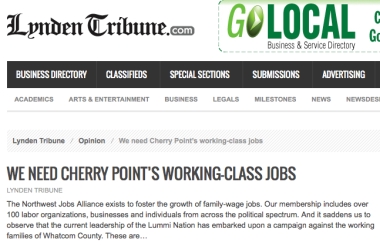 NWJA’s December 23, 2015 Lynden Tribune op-ed claimed that “the current leadership of the Lummi Nation has embarked upon a campaign against the working families of Whatcom County.” In an attempt to support that inflammatory claim, NWJA pointed to a December 10, 2015 letter from Kirk Vinish of the Lummi Nation’s Planning Department. However, a review of that 2-page letter produced no evidence to support such a claim.
NWJA’s December 23, 2015 Lynden Tribune op-ed claimed that “the current leadership of the Lummi Nation has embarked upon a campaign against the working families of Whatcom County.” In an attempt to support that inflammatory claim, NWJA pointed to a December 10, 2015 letter from Kirk Vinish of the Lummi Nation’s Planning Department. However, a review of that 2-page letter produced no evidence to support such a claim.
In contrast, NWJA has left a trail of evidence demonstrating its continued pattern of negative messaging to raise resentment about, and discredit, the Lummi Nation’s opposition to GPT by sending accusatory letters to the Army Corps and Whatcom County, and by disseminating similar accusatory messaging to the public, via the NWJA email list and a press release sent to local media.
In NWJA’s opinion piece, Huntley and Owens also alleged that Lummi Nation leaders are proposing the elimination of existing Cherry Point industry jobs. They provided no evidence whatsoever to support such a claim.
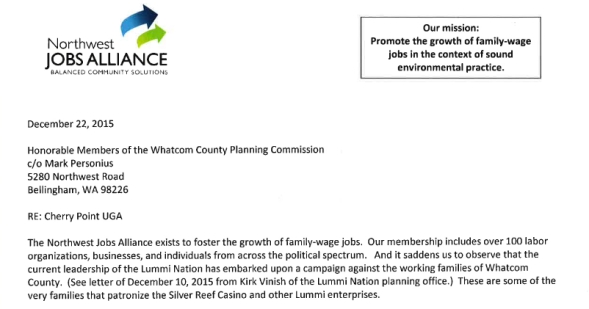
Excerpt from NWJA’s December 22 comment letter to the Whatcom County Planning Commission
As if it weren’t bad enough that NWJA submitted its defamatory op-ed for publication in a local newspaper, the Alliance launched a second strike aimed at Lummi Nation leadership the day before, by submitting a December 22 comment letter to the Whatcom County Planning Commission, on the currently ongoing Whatcom County Comprehensive Plan Update.
The comment letter was a slightly revised version of NWJA’s op-ed published in the Lynden Tribune, containing the same unsubstantiated accusations. NWJA’s inflammatory comment letter is now part of the official public comment record for the County Comprehensive Plan Update which the Whatcom County Council will review prior to voting on the final language to be included in the plan update. The fact that the Council is also one of the decision makers on permits needed by PIT for its GPT project makes NWJA’s comment letter “comprehensively” reprehensible.
GPT threatens Lummi treaty rights
GPT would be sited along the Salish Sea shoreline, at Xwe’chi’eXen, part of the Lummi Nation’s traditional fishing area. Xwe’chi’eXen is the Lummi peoples’ ancestral name for Cherry Point, an area which has a deep cultural, historic and spiritual significance to the Lummi people, as it was a village site for their ancestors for over 175 generations.
The projected coal export terminal threatens Lummi treaty rights, the salmon they depend on, their Schelangen (“Way of Life”), and the cultural integrity of Xwe’chi’eXen. LIBC Chairman Tim Ballew II sent a January 5, 2015 letter to the U.S. Army Corps of Engineers Seattle District Commander, Colonel John G. Buck, asking the agency to take immediate action to deny the GPT permit application.
In that letter, Chairman Ballew stated that the GPT project “will directly result in a substantial impairment of the treaty rights of the Lummi Nation throughout the Nation’s ‘usual and accustomed’ fishing areas.” Ballew also wrote that “The Lummi Nation is opposed to this project due to the cultural and spiritual significance of Xwe’chi’eXen, and intends to use all means necessary to protect it.” He added that the Lummi Nation has a sacred obligation to protect Xwe’chi’eXen based on that significance.

Page excerpt from “Protecting Treaty Rights, Sacred Places, and Lifeways: Coal vs. Communites,” presented by Jewell James, Lummi Tribal Member and Head Carver, Lummi Tribe’s House of Tears Carvers
The U.S. Army Corps of Engineers (“the Corps”) is the federal agency tasked with coordinating and handling the environmental review for the GPT project, and it is legally obligated to ensure that the Lummi Nation’s treaty rights are protected, and are not violated. Currently, the Corps is in the process of making a determination as to whether impacts to any tribes’ U&A (usual and accustomed) treaty fishing rights are more than de minimis, meaning too small or trivial to warrant legal review.

Article VI of the U.S. Constitution which includes the clause that establishes treaties made under its authority, are the supreme law of the land
SSA Marine consultant Craig Cole, Director for NWJA
The Northwest Jobs Alliance (NWJA) was created to promote and advocate for the GPT project. For the first few years, NWJA consisted solely of a Facebook page, after that page had been created in May of 2011. NWJA’s original mission statement that had been displayed for years on its Facebook page read: “The Alliance focuses their efforts on supporting the Gateway Pacific Terminal. . .” For almost three years, NWJA’s Facebook page showed “www.gatewaypacificterminal.com” as its website address, and the phone number displayed had been a non-working number.
Several articles appeared in Whatcom County citizen-based publications during the summer and fall of 2014, criticizing the legitimacy of the NWJA and likening it to a front group, as it did not have a working phone number or a website other than the official GPT website. Subsequently, NWJA made some changes. In fall of 2014, the NWJA added a working phone number, created a website for its online presence, and changed its listed website address on its Facebook page from “gatewaypacificterminal.com” to “NWJA.org.”
Presently, the NWJA website states the following as its mission: “The Northwest Jobs Alliance (NWJA) promotes the growth of family-wage jobs in the context of sound environmental practice.” Also, there is no mention of GPT on the NWJA website’s Home page where the organization’s mission and focus are explained. Instead the general term “Cherry Point industrial area” is used.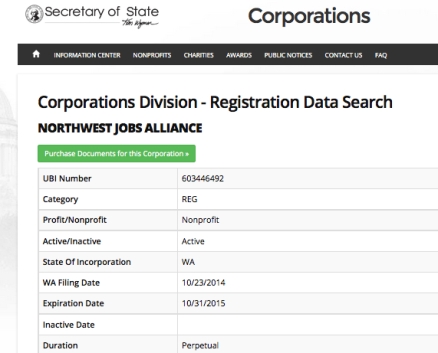 On October 23, 2014, NWJA was filed as a non-profit corporation, according to the Washington Secretary of State website. SSA Marine’s paid local consultant for the GPT project, Bellingham resident Craig Cole, is the listed Director for NWJA.
On October 23, 2014, NWJA was filed as a non-profit corporation, according to the Washington Secretary of State website. SSA Marine’s paid local consultant for the GPT project, Bellingham resident Craig Cole, is the listed Director for NWJA.
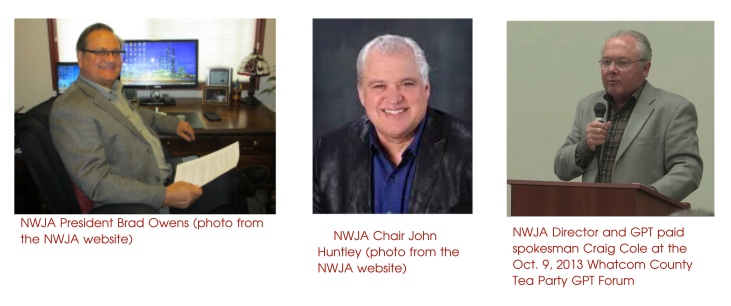 Since its inception, NWJA has had a steady turnover of co-chairs, all of whom have been very public advocates for the GPT project. Presently, Brad Owens is listed as NWJA President and John Huntley is listed as NWJA Chair. Huntley owns Mills Electric, a Bellingham electrical contracting company. Owens, a Bellingham resident, is the past President of the NW Washington Building & Construction Trades Council.
Since its inception, NWJA has had a steady turnover of co-chairs, all of whom have been very public advocates for the GPT project. Presently, Brad Owens is listed as NWJA President and John Huntley is listed as NWJA Chair. Huntley owns Mills Electric, a Bellingham electrical contracting company. Owens, a Bellingham resident, is the past President of the NW Washington Building & Construction Trades Council.
Some people confuse the “Northwest Jobs Alliance” for another similarly titled GPT advocacy organization called the “Alliance for Northwest Jobs and Exports.” It’s worthwhile to distinguish between the two, although promoting the GPT project has been the central intended purpose of both groups.
Cloud Peak Energy and BNSF govern Alliance for NW Jobs & Exports
The Alliance for Northwest Jobs and Exports (ANWJE) was first presented to the public as a grass-roots organization, when it was actually created in 2012, by Edelman, the world’s largest public relations firm, which was hired by SSA Marine to do public relations work for the proposed GPT project.
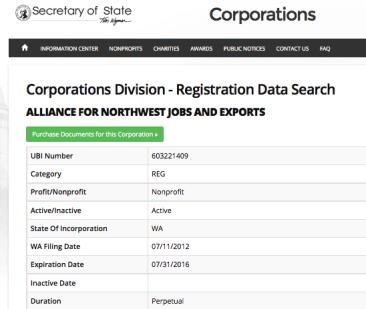 According to the Washington Secretary of State website, ANWJE was filed as a non-profit corporationin July 2012. The “Governing Persons” listed are Todd O’Hair and Zak Andersen. Todd O’Hair is currently Senior Manager, Government Affairs for Cloud Peak Energy Inc. which has a 49% stake in SSA Marine/PIT’s GPT project. Zak Andersen is presently Assistant Vice President, Community and Public Affairs for BNSF Railway.
According to the Washington Secretary of State website, ANWJE was filed as a non-profit corporationin July 2012. The “Governing Persons” listed are Todd O’Hair and Zak Andersen. Todd O’Hair is currently Senior Manager, Government Affairs for Cloud Peak Energy Inc. which has a 49% stake in SSA Marine/PIT’s GPT project. Zak Andersen is presently Assistant Vice President, Community and Public Affairs for BNSF Railway.  BNSF is the applicant for GPT’s interrelated Custer Spur project and would be the railway transporting coal mined in Montana and Wyoming to GPT. ANWJE’s website describes its group as a “non-profit trade organization that supports new export projects in Oregon and Washington State…”
BNSF is the applicant for GPT’s interrelated Custer Spur project and would be the railway transporting coal mined in Montana and Wyoming to GPT. ANWJE’s website describes its group as a “non-profit trade organization that supports new export projects in Oregon and Washington State…”
BNSF Railway, SSA Marine, and Cloud Peak Energy are listed on the ANWJE’s membership list, which is comprised of companies and other entities which stand to benefit financially from the coal export terminal. So, this “non-profit trade organization” was created by the public relations firm hired by the GPT applicant, and it is governed by an employee of BNSF, the applicant for the interrelated Custer Spur project, and by an employee of Cloud Peak Energy, which has a 49% stake in SSA Marine/PIT’s GPT project.
NWJA’s attempt to drive public opinion against Lummi opposition to GPT
Whatcom Tea Party board member Kris Halterman hosts a local Whatcom County KGMI talk radio show, “Saturday Morning Live” (SML). On her September 12, 2015 SML show, Halterman hosted NWJA President Brad Owens, and together, they advanced an unsubstantiated, defamatory assertion that NWJA (the entity behind the Lynden Tribune op-ed) had previously purported in its August 20, 2015 letter to the Corps—that there is “an apparent motive behind the Lummi Nation’s opposition to the Gateway Pacific Terminal project (and completion of the EIS process)not connected with treaty rights.” [italicized emphasis theirs]
Joining in those activities against Lummi opposition to GPT, was the Political Action Committee SAVEWhatcom, headed up by Halterman, whose name pops up in most everything GPT-related. The SAVEWhatcom PAC was the vehicle for Gateway Pacific coal terminal interests to fund 2013 and 2014 local Whatcom County election political campaigns with over $160,000, which, if successful, would benefit those interests.

February 5, 2015 post from the SAVEWhatcom Facebook page
One month after the LIBC’s January 5, 2015 letter to the Corps, Halterman’s SAVEWhatcom placed a February 5 post on its Facebook page which disparaged the Lummi Nation and its Silver Reef Casino in what appeared to be an attempt to drive public opinion against the Lummi Nation’s strong oppositional stance to GPT.
Then, in an August 12, 2015 comment letter to the Whatcom County Planning Commission, NWJA seemed to pit “working families” who were characterized in the letter as “some of the very people who patronize Lummi enterprises”— against what was described as “tribal aspirations.” Echoing that previous tack of drawing attention to the Lummi Nation’s enterprises while at the same time denigrating the Nation with groundless claims, the NWJA referenced the Lummi Nation’s Silver Reef Casino in their December 23, 2015 Lynden Tribune op-ed. That excerpt read:
“And it saddens us to observe that the current leadership of the Lummi Nation has embarked upon a campaign against the working families of Whatcom County. These are some of the very families that patronize the Silver Reef Casino and other Lummi enterprises. Some thanks.”
Those specific repeated references to the Lummi Nation’s Silver Reef Casino and enterprises by SAVEWhatcom and the SSA Marine consultant-led NWJA, could be viewed as attempts to drive public opinion against the Lummi Nation’s Silver Reef enterprises—trying to change the minds of the Silver Reef’s loyal patrons who enjoy the hotel, spa, casino, entertainment/shows, multiple restaurants, convention and event venue, and more.
NWJA omits important statistics
NWJA’s December 23 opinion piece failed to mention that the Lummi Nation’s Silver Reef Hotel Casino & Spa employs 675 people. It also failed to mention any of the significant contributions from the Lummi Nation to Whatcom County’s community at large, which certainly have a positive impact on countless families and individuals in Whatcom County. For example, LIBC Chairman Tim Ballew stated in a May 2015 piece in The Bellingham Herald, that Lummi Nation was “humbled and honored to be able to give back to the people who work so hard to make our community thrive,” when referring to its Nation’s donations of over $600,000 awarded to 43 organizations. Some of those organizations include the Bellingham Food Bank, the Whatcom Literacy Council, and Whatcom County Fire District 8, to name a few.
NWJA stated in its December 23 op-ed and its December 22 comment letter to the County Planning Commission, that “Whatcom County ranks 30th out of 39 counties for personal income growth [Bellingham Herald 11/19/15].” In reading The Bellingham Herald article cited as a source for that statistic, NWJA did not bother to inform readers that while the per capita personal income average in Whatcom County increased 3.2% from 2013 to 2014, placing it 30th out of 39 counties in the state, Whatcom County’s 2014 per capita income total ranks 16th highest out of Washington’s 39 counties.
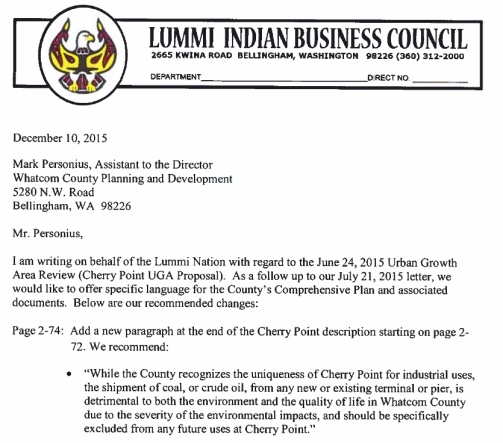
Excerpt from December 10, 2015 comment letter submitted to Whatcom County Planning and Development by the Lummi Nation Planning Department
In its December 23 op-ed, and in its December 22 comment letter NWJA sent to the Planning Commission, Huntley and Owens referenced specific language from the December 10, 2015 comment letter from Lummi Nation’s Planning Department submitted to Whatcom County Planning and Development. The specific language was a new policy that Lummi Nation recommended be added to the County Comprehensive Plan:
“The shipment of coal, or crude oil, from any new shipping terminal or pier, or any existing terminal or pier, is prohibited.” Huntley and Owens said they were troubled by the Lummi Nation’s recommendation and wrote:
“This echoes previous requests that the Lummi have made to the County to begin phasing out the Cherry Point heavy industrial zone.” No evidence, however, was provided by the NWJA to show any previous, or even current, requests from Lummi Nation to begin phasing out the Cherry Point heavy industrial zone.
The underbelly of their reasoning
One particular statement NWJA made in its August 12, 2015 comment letter to the County Planning Commission revealed the underbelly of their reasoning:
“The Lummi occupy an important and unique role in our community, but they are just 1.5% of the County’s population.”
NWJA repeated similar statements in its August 27, 2015 email advertisement disseminated via its mailing list, and in its September 10, 2015 press release, potentially indicating to their audiences a reason to marginalize and dismiss Lummi Nation’s voice based on the Lummi’s minority population status.
Just as “Manifest Destiny” mandated that it was supposedly God’s providence that the U.S. should exercise hegemony over its neighbors—seeing North America as the new Promised Land, NWJA and the GPT corporate interests they advocate for, seem to believe that it’s their economic providence to exercise hegemony over the Lummi Nation—seeing Xwe’chi’eXen (Cherry Point) and its naturally occurring deep-water contours which allow for huge Capesize vessels stuffed with U.S. coal bound for Asia, as their new Promised Land.
The Lummi Nation, however, and countless people in the Pacific Northwest region, have a very different view of their destiny, and that view does not include the transporting, handling, and shipping of 48 million metric tons per year of coal to Asia, which is the plan for GPT.
Raising resentment of tribal treaty rights; encouraging the public and government officials to ignore tribal treaty rights; calling into question the motivation behind an Indian Nation’s exercising of its tribal treaty rights; interfering with the federal regulatory review process and the government to government relationship between a U.S. federal agency and Indian Tribes and Indian Nations; and making disparaging and unsubstantiated accusations against an Indian Nation and its leaders, are some of the various ways in which the Lummi Nation is being attacked as powerful corporations endeavor to realize their perceived manifest destinies, in pursuit of a coal export terminal at Xwe’chi’eXen.

by Deep Green Resistance News Service | Nov 25, 2013 | Climate Change, NEWS
By Suzanne Goldenberg / The Guardian
The climate crisis of the 21st century has been caused largely by just 90 companies, which between them produced nearly two-thirds of the greenhouse gas emissions generated since the dawning of the industrial age, new research suggests.
The companies range from investor-owned firms – household names such as Chevron, Exxon and BP – to state-owned and government-run firms.
The analysis, which was welcomed by the former vice-president Al Gore as a “crucial step forward” found that the vast majority of the firms were in the business of producing oil, gas or coal, found the analysis, which has been published in the journal Climatic Change.
“There are thousands of oil, gas and coal producers in the world,” climate researcher and author Richard Heede at the Climate Accountability Institute in Colorado said. “But the decision makers, the CEOs, or the ministers of coal and oil if you narrow it down to just one person, they could all fit on a Greyhound bus or two.”
Half of the estimated emissions were produced just in the past 25 years – well past the date when governments and corporations became aware that rising greenhouse gas emissions from the burning of coal and oil were causing dangerous climate change.
Many of the same companies are also sitting on substantial reserves of fossil fuel which – if they are burned – puts the world at even greater risk of dangerous climate change.
Climate change experts said the data set was the most ambitious effort so far to hold individual carbon producers, rather than governments, to account.
The United Nations climate change panel, the IPCC, warned in September that at current rates the world stood within 30 years of exhausting its “carbon budget” – the amount of carbon dioxide it could emit without going into the danger zone above 2C warming. The former US vice-president and environmental champion, Al Gore, said the new carbon accounting could re-set the debate about allocating blame for the climate crisis.
Leaders meeting in Warsaw for the UN climate talks this week clashed repeatedly over which countries bore the burden for solving the climate crisis – historic emitters such as America or Europe or the rising economies of India and China.
Gore in his comments said the analysis underlined that it should not fall to governments alone to act on climate change.
“This study is a crucial step forward in our understanding of the evolution of the climate crisis. The public and private sectors alike must do what is necessary to stop global warming,” Gore told the Guardian. “Those who are historically responsible for polluting our atmosphere have a clear obligation to be part of the solution.”
Between them, the 90 companies on the list of top emitters produced 63% of the cumulative global emissions of industrial carbon dioxide and methane between 1751 to 2010, amounting to about 914 gigatonne CO2 emissions, according to the research. All but seven of the 90 were energy companies producing oil, gas and coal. The remaining seven were cement manufacturers.
The list of 90 companies included 50 investor-owned firms – mainly oil companies with widely recognised names such as Chevron, Exxon, BP , and Royal Dutch Shell and coal producers such as British Coal Corp, Peabody Energy and BHP Billiton.
Some 31 of the companies that made the list were state-owned companies such as Saudi Arabia’s Saudi Aramco, Russia’s Gazprom and Norway’s Statoil.
Nine were government run industries, producing mainly coal in countries such as China, the former Soviet Union, North Korea and Poland, the host of this week’s talks.
Experts familiar with Heede’s research and the politics of climate change said they hoped the analysis could help break the deadlock in international climate talks.
“It seemed like maybe this could break the logjam,” said Naomi Oreskes, professor of the history of science at Harvard. “There are all kinds of countries that have produced a tremendous amount of historical emissions that we do not normally talk about. We do not normally talk about Mexico or Poland or Venezuela. So then it’s not just rich v poor, it is also producers v consumers, and resource rich v resource poor.”
Michael Mann, the climate scientist, said he hoped the list would bring greater scrutiny to oil and coal companies’ deployment of their remaining reserves. “What I think could be a game changer here is the potential for clearly fingerprinting the sources of those future emissions,” he said. “It increases the accountability for fossil fuel burning. You can’t burn fossil fuels without the rest of the world knowing about it.”
Others were less optimistic that a more comprehensive accounting of the sources of greenhouse gas emissions would make it easier to achieve the emissions reductions needed to avoid catastrophic climate change.
John Ashton, who served as UK’s chief climate change negotiator for six years, suggested that the findings reaffirmed the central role of fossil fuel producing entities in the economy.
“The challenge we face is to move in the space of not much more than a generation from a carbon-intensive energy system to a carbonneutral energy system. If we don’t do that we stand no chance of keeping climate change within the 2C threshold,” Ashton said.
“By highlighting the way in which a relatively small number of large companies are at the heart of the current carbon-intensive growth model, this report highlights that fundamental challenge.”
Meanwhile, Oreskes, who has written extensively about corporate-funded climate denial, noted that several of the top companies on the list had funded the climate denial movement.
“For me one of the most interesting things to think about was the overlap of large scale producers and the funding of disinformation campaigns, and how that has delayed action,” she said.
The data represents eight years of exhaustive research into carbon emissions over time, as well as the ownership history of the major emitters.
The companies’ operations spanned the globe, with company headquarters in 43 different countries. “These entities extract resources from every oil, natural gas and coal province in the world, and process the fuels into marketable products that are sold to consumers on every nation on Earth,” Heede writes in the paper.
The largest of the investor-owned companies were responsible for an outsized share of emissions. Nearly 30% of emissions were produced just by the top 20 companies, the research found.
By Heede’s calculation, government-run oil and coal companies in the former Soviet Union produced more greenhouse gas emissions than any other entity – just under 8.9% of the total produced over time. China came a close second with its government-run entities accounting for 8.6% of total global emissions.
ChevronTexaco was the leading emitter among investor-owned companies, causing 3.5% of greenhouse gas emissions to date, with Exxon not far behind at 3.2%. In third place, BP caused 2.5% of global emissions to date.
The historic emissions record was constructed using public records and data from the US department of energy’s Carbon Dioxide Information and Analysis Centre, and took account of emissions all along the supply chain.
The centre put global industrial emissions since 1751 at 1,450 gigatonnes.
From The Guardian
Photo by Gene Gallin on Unsplash
by Deep Green Resistance News Service | May 26, 2013 | Colonialism & Conquest, Indigenous Autonomy
By John Vidal / The Observer
Land conflicts between farmers and plantation owners, mining companies and developers have raged across Indonesia as local and multinational companies have been encouraged to seize and then deforest customary land – land owned by indigenous people and administered in accordance with their customs. More than 600 were recorded in 2011, with 22 deaths and hundreds of injuries. The true number is probably far greater, say watchdog groups.
The Indonesian national human rights commission reported more than 5,000 human rights violations last year, mostly linked to deforestation by corporations. “Deaths of farmers caused by the increase in agrarian conflicts all across Indonesia are increasing,” said Henry Sarigih, founder of the Indonesian Peasant Union, which has 700,000 members.
“The presence of palm oil plantations has spawned a new poverty and is triggering a crisis of landlessness and hunger. Human rights violations keep occurring around natural resources in the country and intimidation, forced evictions and torture are common,” said Sarigih. “There are thousands of cases that have not surfaced. Many remain hidden, especially by local authorities,” he says.
Communities complain that they are not warned, consulted or compensated when concessions are handed out and that they are left with no option but to give up their independence and work for minimal wages for the companies.
At fault are badly drafted laws, unclear regulations, corruption and heavy-handed security and paramilitary forces – all of which favour large business over the poor. Illegal land purchases and logging are mostly supported by police, armed forces and local government staff. Companies are even allowed to work with security forces.
Feelings run high when land is taken and livelihoods are wiped out by deforestation. In December 2011, 28 protesters from a logging concession area on Padang island in Sumatra sewed their mouths shut in front of the parliament building in Jakarta in a protest against having their land “grabbed” by a giant paper and pulp company.
Last year, three people were killed in a clash with security forces during a protest over gold prospectors in Bima on the island of Sumbawa. Farmers from Mesuji in Sumatra claimed that security forces murdered residents to evict them from their land.
Over 10m hectares (24.7m acres) of land has been given away and converted to plantations in the last 10 years, forcing thousands of communities to give up forest they have collectively used for generations. Politicians offer land to supporters and give permission to develop plantations with little thought for the human or ecological consequences. In addition, government attempts to move landless people from densely populated areas to less populous areas with “transmigration” policies have caused major conflicts with indigenous groups in provinces like Papua and Sulawesi.
“Who controls the land in Indonesia controls the politics. Corruption is massive around natural resources. We are seeing a new corporate colonialism. In the Suharto era you were sent to prison for talking about the government. Now you can be sent there for talking about corporations,” says Abetnego Tarigan, director of Friends of the Earth Indonesia in Jakarta.
Three of the group’s staff members, including its south Sumatra director, are in prison following protests at the involvement of the police and military in a land dispute involving a state-owned palm oil plantation firm. “The scale of the conflicts is growing. Every day new ones are reported. More and more police are now in the plantations. Government is trying to clamp down on mass protests,” said Tarigan.
“These developments are classed as ‘growth’ but what we are seeing is the collapse of communities of fisherfolk or farmers and increasing poverty. We are exchanging biodiversity for monocultures, local economies for global ones, small-scale producers are becoming labourers and community land is becoming corporate. This is the direction we are going.”
From The Guardian: http://www.guardian.co.uk/world/2013/may/25/indonesia-new-corporate-colonialism















